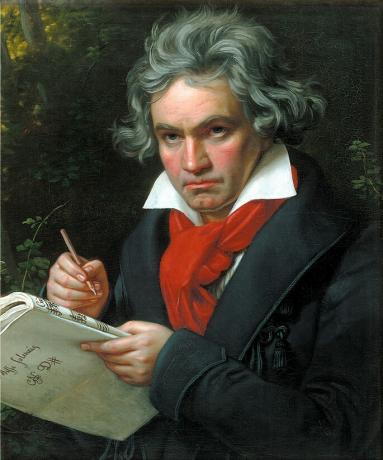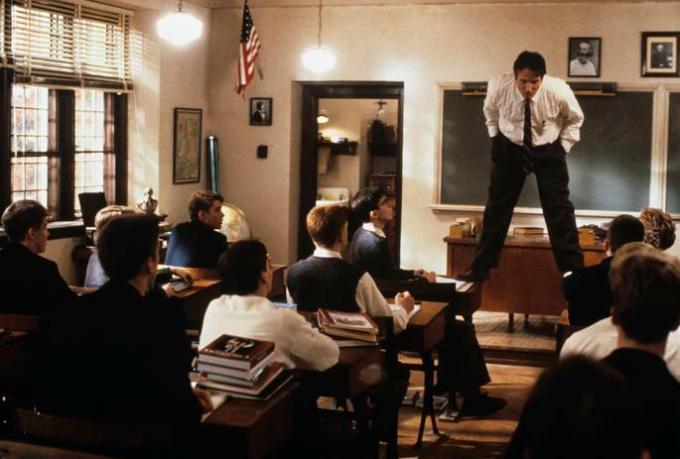Who was Beethoven?
Ludwig van Beethoven was a German pianist, conductor and composer, born in Bonn, Germany, on December 17, 1770 and died in Vienna, on March 26, 1827.
Beethoven produced about 200 works such as sonatas, symphonies, concertos, string quartets. However, he wrote only one opera, “Fidelio”.
The German composer knew how to capture the characteristics of romanticism and wrote works that express ideas and feelings. Furthermore, he innovated by increasing the number of musicians in an orchestra to perform his works and employing a choir in his latest symphony.
Biography
Ludwig Van Beethoven was the son of Johann van Beethoven, musician, and Maria Magdalena Kepenisritch, and was the second child in a family of seven brothers. Born in Bonn, Germany, on December 17, 1770.

His grandfather, Lodewijk van Beethoven, pianist and conductor, held the prestigious position of conductor at the chapel of Prince-Bishop Clement Augustus de Wittelsbach in Cologne. Beethoven's father was also a musician and both encouraged him from an early age to study music.
The father, however, suffered from alcoholism and forced his son to study for many hours, in the hope that he would be a "new Mozart". After his father's death, Beethoven leaves school and starts helping with the family budget by teaching piano and playing at court.
Later, Beethoven would pass under the protection of the Earl of Waldestein, who commissioned several works for the young man. One of the most beautiful sonatas written for piano by Beethoven is called "Waldestein", as it was dedicated to its patron.
However, at age 22, he headed for Vienna, the great musical center of the time. Through the contacts provided by the earl, Beethoven would triumph in the city and would only return to his hometown shortly before he died.
Beethoven's deafness
Around 1800, the composer began to suffer hearing problems as a result of a degenerative disease, which led him to think about suicide.
For the last ten years of his life, Beethoven was completely deaf, but his production did not stop. This was possible because musicians develop the ability to memorize the sound of notes, without having to listen to them.
After several bouts of depression, Beethoven is stricken with pneumonia, cirrhosis and an intestinal infection.
He died in the city of Vienna, Austria, aged 57, on March 26, 1827, when he was composing the 10th symphony.
Unlike many artists, Beethoven was considered a living celebrity. His funeral procession was one of the proofs of this recognition, as it was attended by around 200,000 people.
Characteristics of Beethoven's Works
The composer believed that music was not just for leisure but to express ideas.
Therefore, his works are marked by a strong emotional content, following the characteristics of Romanticism, which dominated European art at that time.
His artistic production is divided into three phases:
- First phase (1792-1800): compositions influenced by Classicism, especially Mozart and Haydn.
- Second phase (1800-1814): considered the most mature phase of the artist in which he writes works such as Symphony No. 3 ("Eroica") and Symphony No. 6 ("Pastoral").
- Third phase (1814-1827): in this period, already suffering from deafness, the composer reached the peak of his creative technique and wrote works of exceptional quality such as the Ninth Symphony.
See too: Romanticism: Characteristics and Historical Context
fifth symphony
The Fifth Symphony or Symphony No. 5 in C minor, op. 67, is one of the composer's most popular pieces and premiered on December 22, 1808, in Vienna.
Its four opening chords made it extremely known to the general public, especially after World War II (1939-1945). After all, the three short times added over the long, meant, in Morse code, the “V” for “victory” (••• –).
These four notes are repeated throughout the first movement in various sections of the orchestra. The listener needs to be attentive, as tension and rest alternate, leaving no one indifferent.
With a little more than half an hour in duration, the work has four movements:
- Allegro con brio
- riding with motorcycle
- Scherzo
- Allegro
Check here a recording of Symphony nº5, performed by West-Eastern Divan Orchestra, under the regency of Daniel Barenboim.
Ninth Symphony
The Ninth Symphony or Symphony No. 9, in D minor, op. 125, was the last symphony composed by the musician.
In this work, Beethoven changed the concept of the symphony, which is strictly instrumental, adding a chorus and soloists in the last movement. For this, he chose the poem "Ode to Joy" (also called "Hymn to Joy") by the German poet Friedrich von Schiller to be sung in the last movement of his composition.
The composer worked for about six years to finish it and dedicated it to the King of Prussia, Frederick Wilhelm III (1770-1840). Its premiere took place on May 7, 1824, in Vienna.
Lasting about 65 minutes, the Ninth Symphony is divided into four movements:
- Allegro ma non troppo, un maestoso
- Molto vivace
- Adagio molto cantabile, andante moderato
- Finale: Presto
Beethoven works
- Trio for piano, violin and cello (1793-1794)
- Concerto for Piano #1 in C major (1795)
- Serenade for Violin, Viola and Cello (1796)
- Sonata Nº8 in C minor - "Pathetic" (1798)
- Symphony No. 1 in C major (1800)
- Sonata Nº21 in C major - "Waldstein" (1804)
- Three String Quartets (1806)
- Mass in C Major (1807)
- Fidelio (1814)
- Missa Solemnis (1823)
- Symphony No.9 in D minor (1822-1824)
- Grand Fugue for Four Hands Piano (1826)
We have more texts on the subject for you:
- high culture
- Music history
- Johann Sebastian Bach



